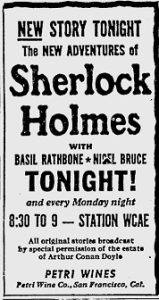
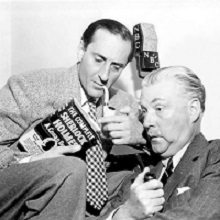 The New Adventures of Sherlock Holmes (1939-47) aired “The Book of Tobit” on March 26, 1945 as the 172nd of the 220 episodes during the Rathbone/Bruce years. Our last episode of The New Adventures of Sherlock Holmes appeared in March of 2021, just over a year go, and this week’s episode is only the 5th since 2017, so I thought it high time for another one. During this incarnation of Sherlock Holmes on radio (the first coming in the early 1930s and the last running to 1959), Basil Rathbone (1892-1967) and Nigel Bruce (1895-1953) reprised their Universal studio film roles of Sherlock Holmes and Dr. Watson for close to 220 episodes. Afraid of being typecast–-and following the cancellation of further Holmes films–-Rathbone wanted out of his radio role. Though the show’s sponsor at the time, Petri Wines, offered him a generous bump in compensation if he would continue, Rathbone declined. Following his final episode as Holmes at the end of May 1946, the Holmes character was played by popular British actor Tom Conway (who was an excellent Holmes), with Bruce staying on until the series end in 1947. For several years during this series (including this episode) scripts were written by the team of future F&SF co-founder Anthony Boucher, and Denis Green. Boucher, a diehard Holmes fan, would pen the outlines of scripts and Green would supply the details. They worked well together and the show flourished.
The New Adventures of Sherlock Holmes (1939-47) aired “The Book of Tobit” on March 26, 1945 as the 172nd of the 220 episodes during the Rathbone/Bruce years. Our last episode of The New Adventures of Sherlock Holmes appeared in March of 2021, just over a year go, and this week’s episode is only the 5th since 2017, so I thought it high time for another one. During this incarnation of Sherlock Holmes on radio (the first coming in the early 1930s and the last running to 1959), Basil Rathbone (1892-1967) and Nigel Bruce (1895-1953) reprised their Universal studio film roles of Sherlock Holmes and Dr. Watson for close to 220 episodes. Afraid of being typecast–-and following the cancellation of further Holmes films–-Rathbone wanted out of his radio role. Though the show’s sponsor at the time, Petri Wines, offered him a generous bump in compensation if he would continue, Rathbone declined. Following his final episode as Holmes at the end of May 1946, the Holmes character was played by popular British actor Tom Conway (who was an excellent Holmes), with Bruce staying on until the series end in 1947. For several years during this series (including this episode) scripts were written by the team of future F&SF co-founder Anthony Boucher, and Denis Green. Boucher, a diehard Holmes fan, would pen the outlines of scripts and Green would supply the details. They worked well together and the show flourished.
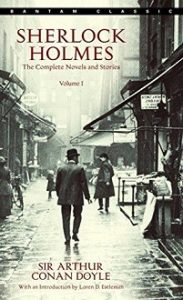 Since 130 years have passed since the first story of Sherlock Holmes and Dr. John Watson appeared in Beeton’s Christmas Annual magazine for December 1887 (A Study in Scarlet), much has been written, filmed, or dramatized of the most famous sleuth on the planet. In fact, the Wikipedia page devoted to Holmes, states that the Guinness Book of World Records’ lists the Holmes character as “the ‘most portrayed movie character in history’ with more than 70 actors playing the part in over 200 films.” And while hardly all inclusive, Wikipedia notes that those writing Holmes pastiches number the likes of Anthony Burgess, Neil Gaiman, Dorothy B. Hughes, Stephen King, Tanith Lee, A. A. Milne, and P. G. Wodehouse–to which I will add Manly Wade Wellman, Philip Jose Farmer, James Lovegrove, George Mann, Kim Newman, and Fred Saberhagen. It’s a sure bet there have been many others of genre interest over the years who have tried their hand at a Sherlock Holmes novel as well.
Since 130 years have passed since the first story of Sherlock Holmes and Dr. John Watson appeared in Beeton’s Christmas Annual magazine for December 1887 (A Study in Scarlet), much has been written, filmed, or dramatized of the most famous sleuth on the planet. In fact, the Wikipedia page devoted to Holmes, states that the Guinness Book of World Records’ lists the Holmes character as “the ‘most portrayed movie character in history’ with more than 70 actors playing the part in over 200 films.” And while hardly all inclusive, Wikipedia notes that those writing Holmes pastiches number the likes of Anthony Burgess, Neil Gaiman, Dorothy B. Hughes, Stephen King, Tanith Lee, A. A. Milne, and P. G. Wodehouse–to which I will add Manly Wade Wellman, Philip Jose Farmer, James Lovegrove, George Mann, Kim Newman, and Fred Saberhagen. It’s a sure bet there have been many others of genre interest over the years who have tried their hand at a Sherlock Holmes novel as well.
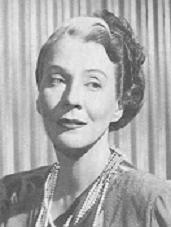 Sherlock Holmes first came to radio solely because of the tireless efforts of one remarkable woman. Edith Meiser (1898-1993) first brought Arthur Conan Doyle’s legendary sleuth to radio in 1930. She would write the scripts based on Holmes’s original adventures for the next 12 years, sometimes branching out to pen tales in the Holmes tradition. Meiser was beloved of Sherlock Holmes fans and members of the Baker Street Irregulars (BSI), but until 1991 the BSI was a male-only organization. However, in part to rectify this situation she was welcomed into the Adventuresses of Sherlock Holmes (ASH), originally an all-female Sherlock Holmes club, though it would later open its doors and become co-ed. The day every year that the BSI would hold its annual dinner, so too would the ASH, with Edith Meiser as its Guest of Honor. During the 1950s Meiser also wrote a daily Holmes comic strip, and was considered a great Broadway actress who also starred in films and early television, including appearances on I Love Lucy. One of the great unsung heroines of early radio (to the outside world at least), she died in 1993.
Sherlock Holmes first came to radio solely because of the tireless efforts of one remarkable woman. Edith Meiser (1898-1993) first brought Arthur Conan Doyle’s legendary sleuth to radio in 1930. She would write the scripts based on Holmes’s original adventures for the next 12 years, sometimes branching out to pen tales in the Holmes tradition. Meiser was beloved of Sherlock Holmes fans and members of the Baker Street Irregulars (BSI), but until 1991 the BSI was a male-only organization. However, in part to rectify this situation she was welcomed into the Adventuresses of Sherlock Holmes (ASH), originally an all-female Sherlock Holmes club, though it would later open its doors and become co-ed. The day every year that the BSI would hold its annual dinner, so too would the ASH, with Edith Meiser as its Guest of Honor. During the 1950s Meiser also wrote a daily Holmes comic strip, and was considered a great Broadway actress who also starred in films and early television, including appearances on I Love Lucy. One of the great unsung heroines of early radio (to the outside world at least), she died in 1993.
“The Book of Tobit” concerns the serial deaths of a woman’s husbands on their wedding night. It begins with Holmes and Watson attending the trial of a beautiful woman being charged in the death of her third husband. When she is found not guilty (as Holmes guessed she would be) it piques his interest–as the oddest things are prone to do with the master sleuth–and Holmes recalls the Old Testament story of the Book of Tobit, said book relating the story of a demon who represents one of the Seven Deadly Sins. The demon is portrayed in several real world ancient texts as representing Lust, and his name is Asmodeus, he who kills husbands on their wedding night. Holmes decides to do a little digging into the history of this particular case and what he learns makes for a most unusual story. All of which turns into a dandy 30 minutes of Old Time Radio with the incomparable Basil Rathbone and Nigel Bruce as our favorite Sherlock Holmes and Dr. Watson.
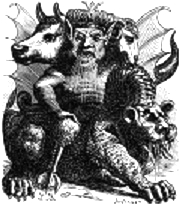
{Pictured above is Asmodeus in the Dictionnaire Infernal by Collin de Plancy. Asmodeus is depicted with the breast of a man, a cock leg, serpent tail, three heads (one of a man spitting fire, one of a sheep, and one of a bull), riding a lion with dragon wings and neck, all of these creatures being associated with either lascivity, lust or revenge.}—from the Asmodues entry in Wikipedia
Play Time: 29:33
{“The Book of Tobit” aired on a Monday evening, which promised that the neighborhood gang would huddle at the corner newsstand after school the next day in search of more odd and strange murder/detective stories. Dime Detective (1931-53) was a long-standing favorite when the mood hit and the cover of the issue below showed why. It was a monthly in 1945. Street & Smith’s Detective Story Magazine (1915-53) was the first pulp magazine focusing exclusively on detective fiction. Actually, the magazine was a continuation of the recently defunct Nick Carter Stories, and even ran the next installment in its first issue of a serial begun in the last issue of the Nick Carter magazine. S&S Detective Story Magazine was a monthly in 1945. Thrilling Detective (1931-53) was another action-filled, long-running competitor to the other magazines shown below, satisfying readers for over 200 issues. It, too, was a monthly in 1945. It is interesting to note that both Dime Detective and Thrilling Detective began in 1931 and ceased publication in 1953, and that all three of the magazines below died in 1953.}
[Left: Dime Detective, Mar. ’45 – Center: Detective Story, Mar. ’45 – Right: Thrilling Detective, Mar. ’45]
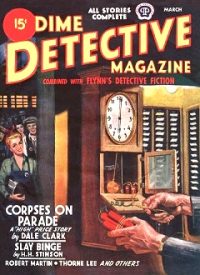
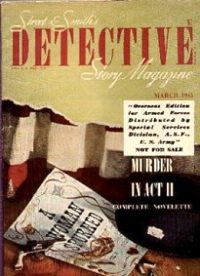
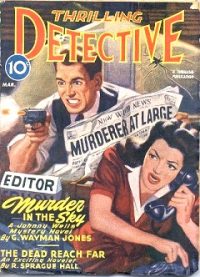
To view the entire list of weekly Old Time Radio episodes at Tangent Online, click here.